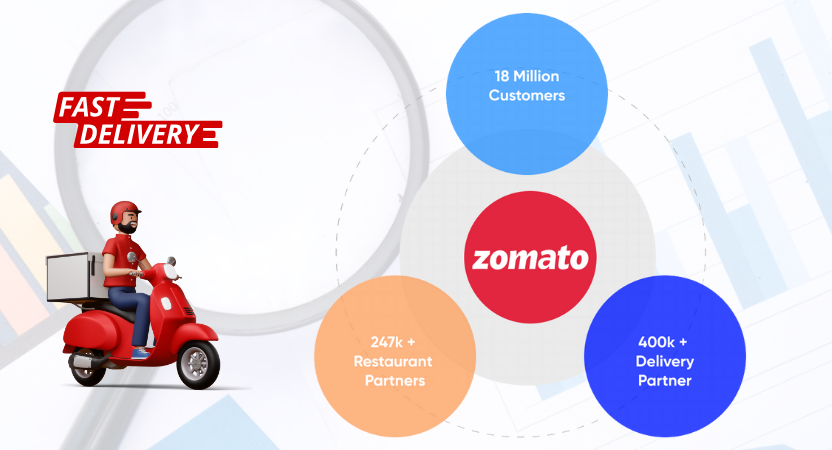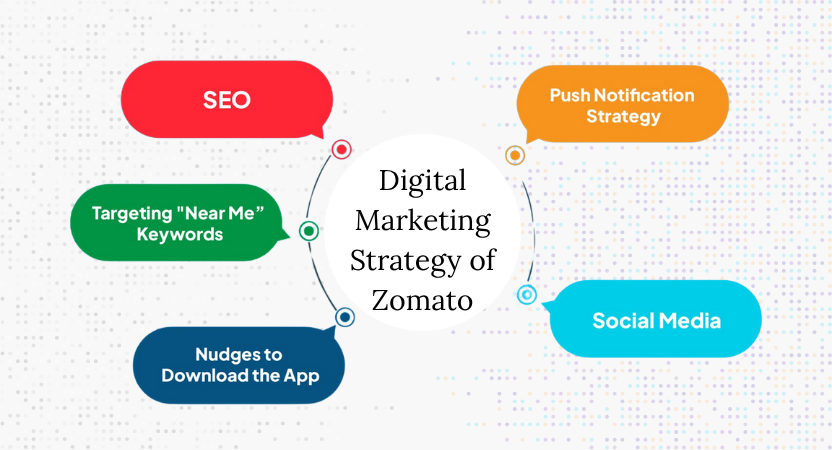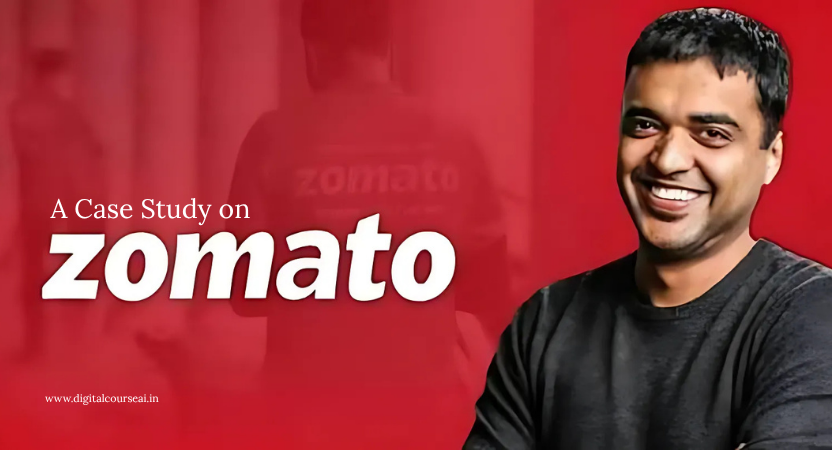In the highly competitive Indian food tech market, Zomato has emerged as a dominant force, redefining the way urban and semi-urban India interacts with food. As of FY 2024–25, Zomato holds a market share of over 55% in the Indian online food delivery segment, directly competing with Swiggy and new entrants like ONDC. With over 10 crore app downloads, 1.5 million active delivery partners, and service presence in 1000+ cities, Zomato has positioned itself as a case study in effective digital transformation, user-centric innovation, and hyper-personalised marketing.
Founded in 2008 by Deepinder Goyal and Pankaj Chaddah, Zomato began as a simple online platform for restaurant menus and reviews, initially named Foodiebay. By 2010, Zomato had transitioned into a full-scale restaurant discovery platform, expanding rapidly across Indian metro cities. Post-2015, the company pivoted aggressively towards the online food ordering and delivery business, responding to the booming demand for home delivery in urban India.
According to RedSeer Consulting, India’s online food delivery market grew at a CAGR of 30% between 2018 and 2023, with Zomato being one of the key contributors. The COVID-19 pandemic further accelerated digital adoption, and by FY 2022–23, Zomato recorded an annual order volume exceeding 450 million and a revenue crossing ₹7,000 crore.
What makes Zomato particularly interesting from a marketing strategy perspective is its ability to adapt and tailor its communication for diverse customer segments across India. The company uses a location-based marketing strategy, combining data analytics, push notifications, meme culture, regional content, influencer partnerships, and app-based engagement models to drive customer retention and acquisition.
Statistical insights from App Annie and Statista reveal that Zomato users spend an average of 13–15 minutes per session on the app, indicating high user engagement. Zomato’s average order value (AOV) stands at ₹400–₹450 in Tier 1 cities and ₹250–₹300 in Tier 2/3 cities, showcasing its diverse pricing adaptability. Furthermore, introducing Zomato Gold (now Zomato Pro) and Hyperpure supply-chain backend operations indicates a long-term strategy to build a vertically integrated food ecosystem.
In addition to food delivery, Zomato has forayed into adjacent sectors like quick commerce (Blinkit), ingredient sourcing for restaurants (Hyperpure), and even intercity food delivery pilots, strengthening its revenue streams and brand perception as a comprehensive food-tech company.
This case study will comprehensively analyse how Zomato strategically uses multi-channel marketing, including digital advertising, SEO, social media, email marketing, and influencer outreach, to build a loyal customer base and stay ahead of competitors. It will also include a SWOT analysis, examine its marketing in Tier 2/3 cities, and highlight its data-first approach to campaign execution, customer retention, and geographic expansion.
Zomato’s journey is not just about food delivery—it’s a textbook example of how technology, when combined with a deep understanding of local markets and agile marketing, can transform consumer behaviour at scale.
Zomato: A Brief Overview
Founded in 2008 by Deepinder Goyal and Pankaj Chaddah, Zomato began as “Foodiebay,” a platform for restaurant listings and reviews. Over the years, it has evolved into a comprehensive food services platform, offering:
- Food Delivery: Connecting users with a vast network of restaurants.
- Dining Out: Providing reviews, ratings, and reservations.
- Zomato Gold/Pro: Subscription services offering exclusive deals.
- Hyperpure: Supplying fresh ingredients to partner restaurants.
Blinkit: Quick commerce platform for groceries and essentials.
Zomato’s Digital Marketing Strategy: A Comprehensive Analysis

Zomato has emerged as a dominant player in the Indian food delivery market, thanks to its innovative and data-driven digital marketing strategies. By effectively leveraging various digital channels, Zomato has enhanced its brand visibility, user engagement, and customer retention. Let’s delve into the key components of Zomato’s digital marketing approach:
1.Search Engine Optimization (SEO): Driving Organic Traffic
Zomato’s robust SEO strategy has been instrumental in attracting organic traffic:
- Keyword Targeting: Zomato targets over 900,000 keywords, including high-intent phrases like “restaurants near me” and “food delivery in [city name],” ensuring a broad online presence.
- Extensive Content Repository: With over 1.4 million listed restaurants, each having dedicated pages featuring menus, reviews, and photos, Zomato boasts a substantial number of indexed pages, enhancing its visibility on search engines.
- Quality Backlinks: Zomato has secured backlinks from approximately 58,000 websites, including high-authority domains like .gov and .edu, boosting its domain authority.
- Localized Content: By creating region-specific content, including city guides and localized menus, Zomato caters to diverse user preferences across different regions.
Impact: These SEO efforts have resulted in Zomato receiving over 30 million monthly organic visits, outperforming competitors like Swiggy.
2.Social Media Engagement: Building Brand Personality
Zomato’s social media strategy focuses on creating relatable and engaging content:
- Platform Presence: As of July 2024, Zomato has 994k followers on Instagram and 1.9 million on Facebook.
- Meme Marketing: Zomato leverages trending memes and pop culture references to create humorous content that resonates with its audience.
- Festival Promotions: Tailoring content around Indian festivals helps Zomato tap into the celebratory mood and connect with users on a cultural level.
Impact: This approach has led to high engagement rates, with users actively sharing and interacting with Zomato’s content, thereby increasing brand visibility and loyalty.
3.Push Notifications: Personalized User Engagement
Zomato employs push notifications to maintain user engagement:
- Timely Alerts: Notifications about meal times, exclusive offers, and weather-based suggestions keep users informed and engaged.
- Personalization: Messages are tailored based on user behavior and preferences, enhancing relevance and effectiveness.
Impact: This strategy has led to a 45% increase in order frequency among users who opt in for notifications and a 60% higher retention rate compared to those who don’t receive them.
4.Influencer Collaborations: Expanding Reach
Zomato partners with influencers to reach diverse audience segments:
- Local Influencers: Collaborations with regional content creators help Zomato tap into specific markets and build trust within local communities.
- Celebrity Endorsements: Associating with popular figures enhances brand credibility and attracts a broader audience.
Impact: These partnerships have increased brand visibility, user engagement, and app downloads, particularly among urban millennials and Gen Z consumers.
5.Email and WhatsApp Marketing: Direct Communication Channels
Zomato utilizes email and WhatsApp to communicate with users:
- Personalized Emails: Based on user preferences and order history, Zomato sends tailored emails featuring offers and recommendations.
- WhatsApp Messages: Quick updates on order status and promotional offers are shared via WhatsApp, ensuring timely communication.
Impact: Email campaigns have achieved open rates exceeding 60%, effectively re-engaging inactive users and fostering customer retention.
6.Localized Marketing: Catering to Regional Preferences
Zomato’s localized marketing strategy involves:
- Region-Specific Campaigns: Creating content that reflects local trends, cultural nuances, and regional languages to resonate with specific audiences.
- Targeted Offers: Providing promotions that align with regional festivals and holidays, strengthening community connections.
Impact: This approach has enabled Zomato to maintain visibility and scale efficiently in different markets while maintaining a strong local presence.
Also Read :- Reliance Jio Case Study
Zomato’s Success Blueprint: 5 Key Digital Marketing Takeaways Every Brand Should Learn

In the dynamic world of digital marketing, where consumer behavior changes with every trend, brands must stay sharp, creative, and deeply connected with their audience. Zomato stands out as a powerful example of how smart marketing can turn a startup into a household name. By blending data, creativity, and personalization, Zomato has built a brand that resonates with millions across India. Let’s explore five powerful digital marketing strategies from Zomato’s journey that any business, big or small, can adopt to boost visibility, engagement, and growth.
1.Strong SEO Strategy = Organic Growth Engine
Search Engine Optimization (SEO) is one of the biggest contributors to Zomato’s massive web traffic. Zomato ranks for over 900,000+ keywords and gets 30+ million organic visits per month. This level of reach is possible because Zomato focuses on:
- Long-tail keywords like “best butter chicken in Delhi”
- Mobile-friendly and fast-loading pages
- Local SEO with listings of restaurants in every city
- High-quality backlinks from trusted sources
Takeaway: Every brand should treat SEO as a long-term investment. A well-structured SEO strategy reduces paid ad costs and increases visibility even during low-budget periods.
2.Relatable Social Media Builds Brand Love
Zomato doesn’t just sell food; it sells emotions. Its social media content is funny, relatable, and rooted in everyday Indian life. With 994K followers on Instagram and 1.9M on Facebook, Zomato’s witty memes and festival posts generate thousands of shares.
Zomato’s social media presence is both entertaining and informative:
- Memes and Relatable Content: Sharing humorous posts that resonate with the youth.
- Interactive Campaigns: Polls, quizzes, and contests to engage users.
- Festival Promotions: Tailoring content around Indian festivals to tap into the celebratory mood.
Example: A post saying “You’re not hungry, you’re just bored – Order Zomato anyway” struck a chord with the youth and boosted app traffic during non-peak hours.
Takeaway: Brands should build a unique voice on social media. Humor, relevance, and consistency make audiences remember and trust you.
3.Personalization Is the Future of Engagement
Zomato uses push notifications, emails, and WhatsApp messages in a smart and personalized way. Notifications are sent around meal times, weather conditions, and even based on users’ past orders. This helps increase click-through rates.
Brands that use personalized marketing see 20% higher sales than those that don’t (source: Campaign Monitor, 2023).
Zomato sends timely and personalized notifications to users:
- Order Reminders: Nudging users around meal times.
- Exclusive Offers: Informing about discounts and deals.
- Weather-Based Suggestions: For instance, promoting hot soups on rainy days.
Takeaway: Personalize everything – from offers to notifications. The more your message feels “for me,” the better the user response.
4.Influencer Marketing Drives Trust and Reach
Zomato regularly collaborates with food bloggers and regional influencers. A single Instagram Reel from a popular food creator can result in 50 K+ views in a day, driving both awareness and downloads.
Zomato also works with celebrities occasionally to reach wider audiences.
Partnering with food bloggers and influencers helps Zomato reach niche audiences:
- Local Influencers: Collaborations with regional content creators to tap into specific markets.
- Celebrity Endorsements: Associating with popular figures to enhance brand credibility.
Takeaway: Start small – work with micro-influencers in your niche or city. Focus on trust, reviews, and relatable storytelling, not just polished ads.
5.Localization Wins Over Generic Marketing
India is a diverse country. Zomato smartly adapts its campaigns for different regions, festivals, and even food preferences. For example, during Onam in Kerala, they promote Sadya meals; during winters in Delhi, they push hot coffee and soup combos.
Zomato keeps users informed through:
- Personalized Emails: Based on user preferences and order history.
- WhatsApp Messages: Quick updates on order status and promotional offers.
Takeaway: Brands that respect and reflect regional tastes get better user connections. Always localize your message for a stronger impact.
Zomato’s Successful Expansion into Tier 2 and Tier 3 Cities
Zomato initially made its mark in India’s large metropolitan cities like Delhi, Mumbai, Bengaluru, and Chennai, where internet penetration, smartphone usage, and digital payment adoption were relatively high. However, as the food delivery market in these metros became increasingly competitive, Zomato saw an opportunity in the smaller towns and cities across India. These Tier 2 and Tier 3 cities presented a huge, largely untapped market with rising internet usage and changing lifestyles. But expanding into these areas was not straightforward. The challenge was to adapt its business model and marketing approach to fit the unique needs and preferences of these diverse regions.
Zomato’s Successful Expansion into Tier 2 and Tier 3 Cities
- Localized Content and Language Support
Understanding that language is a big barrier in many smaller cities, Zomato made sure its app and marketing communications were available in multiple regional languages such as Hindi, Tamil, Telugu, Marathi, Bengali, and Kannada. This made the platform more accessible and user-friendly for customers who were more comfortable using their native languages. Alongside this, Zomato tailored promotional messages and campaigns to resonate with local culture, festivals, and food habits, making users feel the brand was relevant to their daily lives. - Cash on Delivery (COD) Option
Unlike metro users, a significant portion of customers in Tier 2 and Tier 3 cities still preferred cash payments over digital wallets or cards due to lower digital literacy or lack of access to banking facilities. Zomato adapted by heavily promoting the Cash on Delivery payment method in these areas. This simple but important change removed a key barrier to ordering online food, encouraging many first-time users to try the platform without worrying about digital transactions. - Affordable Pricing and Value Options
Price sensitivity is higher in smaller towns compared to big cities. Zomato responded by introducing budget-friendly meal options, discount offers, and combo deals specifically designed for price-conscious customers. Partnering with local eateries to create special, affordable menus helped the platform attract a wider customer base without compromising quality. Regular promotions during festivals and weekends further boosted order volumes by appealing to users looking for value deals. - Community Engagement and Local Partnerships
Zomato invested time in building strong relationships with local restaurants and food vendors, many of whom were new to digital platforms. The company provided training and support to onboard these businesses, helping them showcase their offerings online and improve delivery logistics. By understanding the unique food preferences of each region—whether it was street food in Lucknow or traditional sweets in Amritsar—Zomato ensured that customers could find familiar and beloved dishes on the app, increasing user satisfaction.
Outcomes
- Rapid Increase in User Base
Within a few months of these strategic changes, Zomato saw a significant rise in the number of daily active users from Tier 2 and Tier 3 cities. Cities like Indore, Coimbatore, and Guwahati became strong contributors to the company’s overall user growth, highlighting the success of localized marketing and service adjustments. - Higher Order Volumes
The introduction of affordable pricing and COD payments led to a noticeable surge in order frequency. This was especially evident during local festivals like Makar Sankranti, Ganesh Chaturthi, and Bihu, where orders spiked as people preferred convenient food delivery over cooking at home. - Improved Brand Loyalty
Positive experiences and word-of-mouth recommendations helped Zomato establish itself as a trustworthy brand in new markets. Repeat orders and app engagement rates steadily increased, indicating growing customer loyalty. The local community felt valued and connected, which is crucial for long-term success.
Zomato’s focused approach in Tier 2 and Tier 3 cities serves as a great example of how understanding regional differences and customizing offerings can drive growth in emerging markets. Their success highlights the importance of flexibility, cultural sensitivity, and affordable solutions when expanding beyond metropolitan areas.
SWOT Analysis of Zomato
| Strength | Weakness |
| Strong brand recognition | Dependence on delivery partners |
| Diverse Service Offerings | Thin profit margins |
| Excellent digital Presence | Intense Competition |
| Opportunities | Threats |
| Expansion into new markets | Regulatory Challenges |
| Introduction of new services | Changing consumer preferences |
| Technological advancement | Economic Downturns |
Infographic: Zomato’s Marketing Channels

Zomato’s Multi-Channel Marketing Approach
- Digital Advertising: Google Ads, Display Networks, YouTube.
- SEO: Optimized website content, mobile-friendly design.
- Social Media: Engaging posts on Instagram, Facebook, and Twitter.
- Push Notifications: Personalized alerts and reminders.
- Influencer Marketing: Collaborations with food bloggers and celebrities.
- Email & WhatsApp: Direct communication with users.
Lessons for Marketers
Zomato’s marketing journey offers valuable insights:
- Understand Your Audience: Tailor content and services to meet the specific needs of different user segments.
- Leverage Multiple Channels: A diversified approach ensures broader reach and engagement.
- Stay Agile: Continuously adapt strategies based on market feedback and trends.
Build Community: Engage with users beyond transactions to foster loyalty.
Conclusion
Zomato’s rise in the Indian food delivery landscape is a testament to its innovative and user-centric marketing strategies. By blending technology with a deep understanding of Indian consumers, Zomato has not only captured a significant market share but also set benchmarks for others in the industry.
Also Read :- Starbucks Case Study

